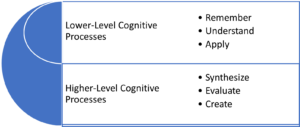Designing Assessments
In order to accurately measure students’ learning, it is important to spend sufficient time developing an effective assessment. One of the tools we use to design a new assessment is a table of specifications (see Table 5.1) A table of specifications includes information about the learning objectives or topics covered in the unit being assessed, the percentage of total instruction time spent on each topic, and the level of cognitive challenge we want to use to check students’ knowledge of each of the topics.
Table 5.1
| Learning Objective/ Topic | Percent of Time | Level of Bloom’s Taxonomy | |||||
|---|---|---|---|---|---|---|---|
| Remember | Understand | Apply | Analyze | Evaluate | Create | ||
| Lower-Level Cognitive Process | Higher-Level Cognitive Process | ||||||
To Complete a Tables of Specifications:
First, list all the learning objectives or topics from the unit of study and indicate the percentage of total instruction time that was spent addressing each. For example, if there were a total of 12 lessons for the unit, and three lessons were spent on the first learning objective, you will state the learning objective in the first column and indicate 25% in the second column.
Note that because the table of specifications identifies the specific learning objectives from the unit, it helps ensure the validity of that assessment for that unit. You can be certain you are checking students’ knowledge of the material you intended for them to learn during your instruction of the unit because the assessment design is tied directly to the unit’s learning objectives.
Next, Indicate the level of cognitive challenge you wish to use on the assessment items for each of the learning objectives, using the levels of Bloom’s Taxonomy [note this will eventually link to the section in chapter 4 about the taxonomy – to be written] (see Figure 5.1).
Decide if it is sufficient for the students to demonstrate lower-level cognition for that learning objective, such as remembering, understanding, or applying their knowledge and indicate that in the table.
On the other hand, you may want students to demonstrate more complex and abstract knowledge of the learning objective, such as analyzing, evaluating, or creating information. Those are higher-level cognitive processes in Bloom’s Taxonomy.
Your choice of the lower-level or higher-level cognitive processes should reflect the learning activities students experienced during instruction for that learning objective. That is, if students were required to demonstrate only simple and concrete knowledge related to that learning objective in class activities, the items on the assessment should then require only lower-level cognitive processing. If students completed more complex and abstract tasks when learning the material, the assessment items should also require higher-level cognitive processing. See Figure 5.2 for examples of the types of tasks that use lower-level and higher-level cognitive processing.
Figure 5.1: Bloom’s Taxonomy

Figure 5.2
Example Student Tasks at Each Level of Bloom’s Taxonomy
Lower-Level Cognitive Processes
- Remember: recall information, list facts
- Understand: define concepts, explain information
- Apply: use knowledge to solve a problem, demonstrate a skill
Higher-Level Cognitive Processes
- Analyze: compare and contrast information, develop a graphic organizer
- Evaluate: judge a product using specific criteria, check use of standards in a process
- Create: write an original story or poem, construct a portfolio
Sometimes it is sufficient for students to only remember the information they learned. Other times, we want them to be able to process the information at a higher level of cognitive challenge. You may be able to use the words of the learning objectives to guide this decision. The words used to write learning objectives often indicate the level of cognitive processing expected and will be helpful when completing the Table of Specifications.

In our case study, Mr. Moller’s exam for the social studies unit about early river valley civilizations addressed the learning objectives listed below. There were 20 lessons of instruction in the unit, and the number of lessons for each objective is indicated.
- Identify the characteristics of a civilization. (2 lessons)
- Explain how geographic factors predicted the location of early River Valley Civilizations. (1 lesson)
- Discuss the role of religion and government in the early civilizations and their interaction in developing cultures. (5 lessons)
- Describe at least one technological achievement from each civilization and how it improved the lives of the people. (4 lessons)
- Analyze the effects of wealth, power, and gender on job specialization in the early River Valley Civilizations. (8 lessons)
Using this information, Mr. Moller constructed a Table of Specifications to guide his writing of the assessment:
| Learning Objective/ Topic | Percent of Time | Level of Bloom’s Taxonomy | |||||
|---|---|---|---|---|---|---|---|
| Remember | Understand | Apply | Analyze | Evaluate | Create | ||
| Lower-Level Cognitive Process | Higher-Level Cognitive Process | ||||||
| 1 | 10% | X | |||||
| 2 | 5% | X | |||||
| 3 | 25% | X | |||||
| 4 | 20% | X | |||||
| 5 | 40% | X | |||||
Think About It
Identify a unit of study in the subject area you are planning to teach. Construct a Table of Specifications for an assessment for that unit. Include at least three learning objectives for the unit, estimate the percentage of instruction time needed for instruction of each objective, and indicate whether, in your opinion, assessment items for the learning objective should require lower-level or higher-level cognitive processes.
A table of specifications is used to design an assessment. It includes information about the learning objectives or topics covered in the unit being assessed, the percentage of total instruction time spent on each topic, and the level of cognitive challenge to use to check students’ knowledge of each of the topics
A valid assessment is one that measures all the concepts it is intended to measure, and only those concepts
